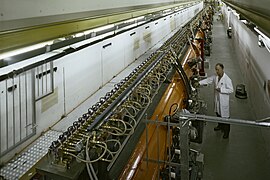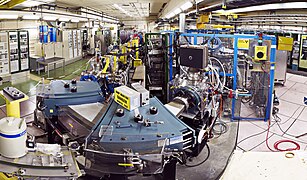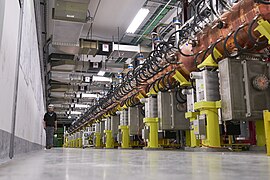CERN Hadron Linacs
| CERN's accelerator complex | |
|---|---|
| List of the current particle accelerators at CERN |
|
| Linac 2 | Accelerates protons |
| Linac 3 | Accelerates ions |
| Linac 4 | Accelerates negative hydrogen ions |
| AD | Brakes antiprotons |
| LHC | Collides protons or heavy ions |
| LEIR | Accelerates lead ions |
| PSB | Accelerates protons or ions |
| PS | Mainly accelerates protons |
| PLC | Accelerates protons, among other things |
The CERN Hadron Linacs are a group of particle accelerators in the large-scale physical research facility CERN . With them is linear accelerator ( Lin ear Ac celerators), the beams of hadrons speed, before they are used by the following accelerators and experiments at CERN.
Linac 1
Linac 1 was CERN's first linear accelerator and accelerated protons to 50 MeV for injection into the Proton Synchrotron (PS). The machine was developed in the early 1950s, based on the design of a similar accelerator at AERE in England. In 1958 protons were accelerated for the first time with a current of 5 mA and a pulse length of 20 μs. These values corresponded to the world record at the time. In September 1959, the targeted energy of 50 MeV was reached, making the accelerator completely functional.
From then on, Linac 1 went through a phase of constant improvement measures and rapid technical developments, which reached their peak in 1978, when a maximum proton current of 70 mA was achieved at pulse lengths of 100 μs. From 1972 Linac 1 no longer delivered the protons directly to the PS, but to the newly completed Proton Synchrotron Booster (PSB). The PSB was built to reach higher proton energies before entering the PS.
After Linac 2 took over the acceleration of protons in 1978, Linac 1 continued to be used as a reliable testing system for new developments. For example, the radio frequency quadrupole was tested, which replaced the original 500 keV - Cockcroft-Walton accelerator in 1984 . In addition, methods for the generation and acceleration of deuterons , α-particles and H - ions were developed. The latter were used as test beams for the Low Energy Antiproton Ring (LEAR).
From the end of 1986 Linac 1 was also used to accelerate oxygen and sulfur ions.
Linac 1 was used for experiments until 1992.
Linac 2
Over the years it became clear that Linac 1 could no longer keep up with the technical advances made by the other machines in CERN's accelerator facility. It was originally discussed to give Linac 1 a major upgrade instead of building a completely new machine. However, it quickly became clear that such an upgrade would be almost as expensive as a completely new design. In addition, building a new Linac would ensure a smooth transition from one linear accelerator to another without major disruptions. For these reasons, it was decided in 1963 to build a new linear accelerator, Linac 2 . This accelerated the protons to the same energy as Linac 1 (50 MeV), but delivered more intense proton beams at up to 150 mA and a longer pulse duration of 200 μs.
Construction of Linac 2 began in December 1973, with a budget of CHF 21.3 million , and was completed in 1978.
In the course of its operation, Linac 2 has been modernized several times. The most important improvement measure was the installation of the radio frequency quadrupole, which replaced the 750 keV - Cockcroft-Walton accelerator in 1993. This enabled the output current to be increased to 180 mA.
Linac 3
Linac 3 was built in the Linac 1 tunnel and commissioned in the summer of 1994. This linear accelerator was specially designed for the acceleration of heavy ions: mainly lead ions, which are made available to the PSB, the Large Hadron Collider (LHC) and the target experiments (see colliding beam experiment ) at the SPS and the LEIR . When LEIR was put into operation, oxygen ions were also accelerated.
As of 2013, Linac 3 was adapted to accelerate argon ions in 2015 . These were used by the NA61 / SHINE experiment .
Likewise, Linac 3 accelerated xenon ions for NA61 / SHINE in 2017 . On October 12, 2017, these were injected into the LHC; for the first time xenon ions were accelerated there and brought to collision. The four LHC experiments recorded data on colliding xenon ions for six hours.
Linac 3 is expected to remain operational until at least 2022.
Linac 4
Linac 4 is a future linear accelerator that will replace Linac 2 in 2020 and is currently being put into operation. Linac 4 is negative hydrogen - ions accelerate to an energy of 160 MeV. The ions are injected into the PSB, where both electrons are then removed, leaving only the nucleus (a proton). By initially using hydrogen ions instead of protons, the beam loss at the injection point is reduced. This also makes it possible to accumulate more protons in the PSB in order to then accelerate them further.
With an energy of 160 MeV, Linac 4 will achieve more than three times as much energy as Linac 2. This increase, combined with the increased accumulation of particles, will allow twice the intensity of the beam in the LHC. This is part of the LHC's planned increase in luminosity , which is set for 2021.
Web links
Individual evidence
- ↑ a b c d e History, Developments and Recent Performance of the CERN Linac 1 , accessed on July 18, 2018
- ↑ CERN Homepage: Linear accelerator 1 , accessed on July 20, 2018
- ↑ BHWolf et al. Nuclear Instruments and Methods in Physics Research Section A Volume 258, Issue 1, 15 July 1987, Pages 1-8 doi : 10.1016 / 0168-9002 (87) 90074-X 2011 Elsevier, accessed November 29, 2011
- ↑ CERN Document Server: first tank of Linac 1 , accessed on November 28, 2011
- ↑ E. Boltezer et al .: The New CERN 50-MeV LINAC (1979) , accessed July 10, 2018
- ^ Project study for a new 50 MeV linear accelerator for the CP S (1973) , accessed July 18, 2018
- ↑ Linac4 Technical Design Report , accessed July 18, 2018
- ^ L. Dumas et al .: Operation of the GTS-LHC Source for the Hadron Injector at CERN , accessed July 23, 2018
- ^ D Küchler et al .: Never Run Your ECR Ion Source with Argon in Afterglow for 6 Months! , accessed July 20, 2018
- ↑ SHINE Homepage: NA61 / SHINE Sheds Light on Strong Interactions , accessed July 20, 2018
- ↑ CERN Homepage: LHC report: xenon in action , accessed on July 20, 2018
- ↑ CERN Homepage: Linear accelerator 3 , accessed on July 20, 2018
- ↑ CERN Homepage: Linear accelerator 4 , accessed on July 20, 2018
- ↑ CERN unveils new linear accelerator (en) . In: symmetry magazine .





